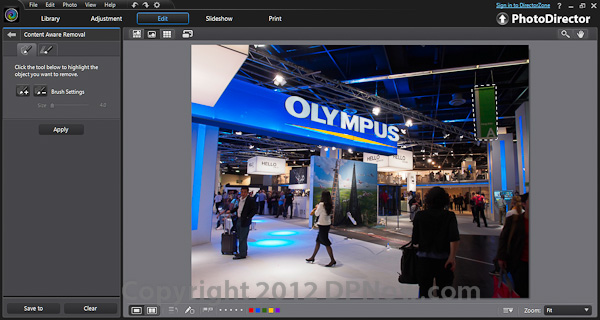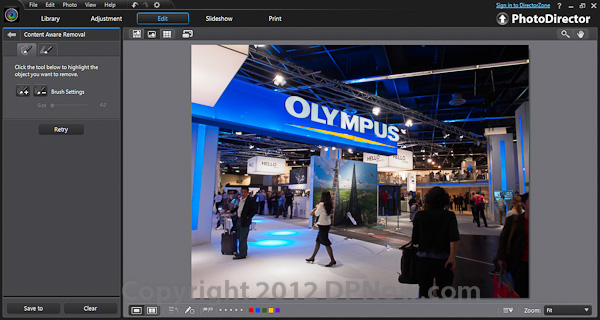PhotoDirector 4 features evolution continues

CyberLink's PhotoDirector is inspired by Adobe's Photoshop Lightroom that combines the benefits of managing your library of images, raw conversion, image adjustments and advanced workflow with slick batch processing. But if you want to make more complex alterations to your images, with Lightroom you need to use a separate image editor, like Photoshop. PhotoDirector incorporates many of the tools you might need in an external editor.
CyberLink has just unveiled the latest version of its £239.99 Director Suite which includes PowerDirector 11for video editing, PhotoDirector 4 for photo editing and management, ColorDirector for advanced video colour effects, and AudioDirector for audio editing and effect, among other content. All these components can be bought separately and in sub-suites. CyberLink is not just a purveyor of cut-price alternative software and although it is now the leading supplier of PC bundled applications its software competes head on with more expensive premium titles. CyberLink is also pushing its rivals; the PowerDirector video editor has some clever and unique hardware acceleration that enables it to simultaneously harness an integrated graphics GPU and a discrete GPU if both are present, meaning CyberLink claim to have the fastest video rendering capability out there. Their new ColorDirector application is unique in the affordable end of the market, inspired by the still image editor, PhotoDirector, Color Director offers powerful colour adjustment and effects for video that can be applied to areas and regions of a scene and automatically tracked as the video sequence plays on. Audio Director is a new sound editor that has some very interesting capabilities for identifying unwanted noises in a recording using visual representation so that they can be easily and conveniently filtered out.
I have had a quick play with PhotoDirector 4 and as with the previous versions of PhotoDirector I continue to be impressed with CyberLink's development of this thoroughly modern photo editing tool.

Lightroom users will, at a glance think they are seeing their favourite software, but PhotoDirector 4 goes where Lightroom stops in terms of more complex image editing.
PhotoDirector 4 works in much the same way as Adobe Photoshop Lightroom; instead of the more traditional workflow model where you load a single image at a time into the editor and then make changes and finally save the edited version, PhotoDirector imports images into its database enabling you to tag images manually or automatically on import. You can then easily find and select images you want to adjust. Changes you make are non-destructive, so you see the changes on-screen in real time but the actual changes are only made when you have finished and you export an adjusted version of the original image, which is never changed so originals are preserved. Adjustments can be made globally or selectively using and adjustment brush or a graduated filter. If you want to apply the same, or a selection of, adjustments to more than one image you can synchronise the selected changes with any number of images. PhotoDirector also works with RAW files, and implements the official SDKs for Nikon and Canon RAW files.
So far this is exactly what Lightroom does. But what if you want to extract a complex shaped object or to make size changes to a particular area of the image. And what about pre-set special effects? How about content-aware object removal that repairs the hole automatically left behind? With Lightroom you would need to have Photoshop or another external application to execute these edits, but not with PhotoDirector. Here are some examples of what PhotoDirector 4 can do:
Background removal and object extraction

Above is a shot I took on a camera manufacturer's booth at this week's Photokina trade show in Cologne, Germany. I decided to post a picture of the sectioned camera on one of our forums. First I straightened it, which is a conventional process similar to that in Lightroom.

This next part you can't do in Lightroom; using a smart selection brush I was able to mask out the unwanted background. Selection enhancement controls are provided to enable a very sophisticated selection that can cope well with fine details like hair, for example.

And here is the result; the camera object has been quickly and conveniently separated from the background.
Content Aware Removal

Next is a demonstration of content-aware removal in PhotoDirector 4. Once again you use painting tools to select the unwanted object, which in this example is a sign hanging from the ceiling of one of the Photokina exhibition halls. It is identified by the dotted white marquee outline in the top right of the image.

You can then delete the selected object and PhotoDirector automatically and intelligently samples surrounding details to fill in the hole left behind. Content aware removal has been featured in Photoshop for a couple of years now and it does appear that PhotoDirector's version works similarly.
PhotoDirector also features preset special effects and there is talk of being able to download additional effects from CyberLink's support site for its Director Suite titles. Another new tool is a body-shape morphing tool that can change the size of sections of an image and protect surrounding areas; ideal slimming down yourself in your holiday snaps! Morphing is also possible using a user-configurable grid that can be applied to the entire image or a specific area, and then you can pull and push anchor points to massage the image into shape.
If that wasn't enough, there is now face-tagging to speed up the job of finding people in your image library. You can also find images containing more than one individual. CyberLink as also improved its tone adjustment and white balance controls and introduced a new HDR tool, complete with Glow and Edge adjustments. Another new feature is an automatic purple fringing or chromatic aberration fixing tool.
So you can see that CyberLink has produced a very versatile package that manages your photos, and convert RAW files, enables you to enhance and correct your photos, as well as apply special effects and more complex object edits applied to one or any number of your images. Undeniably, Lightroom has set new standards for image adjustment flexibility and quality. So it will be interesting to see how well PhotoDirector 4 compares in day to day use. I'll be reporting back on just this topic in due course.
Reader feedback:
Discuss this story:




